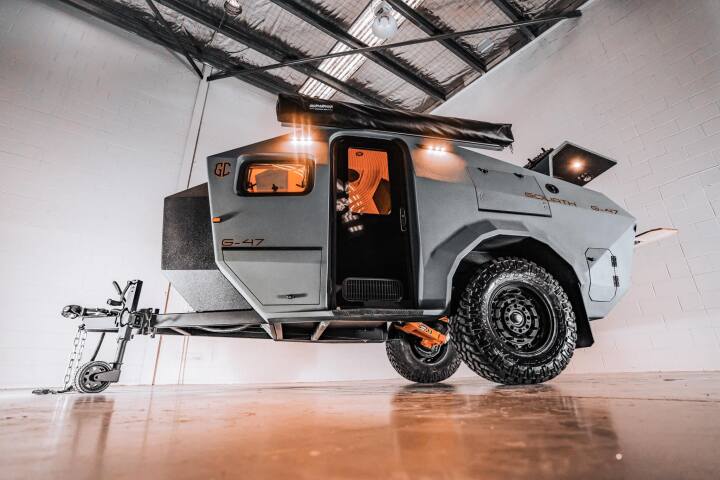Earlier this month, Royal Caribbean’s Quantum of the Seas cruise ship, with its high-tech Bionic Bar and Two70 multimedia theater, set sail on its maiden voyage. Gizmag chatted on the phone with one of the key people behind the interactive performance venue Two70, Tim Magill of 5+design, for a look behind the scenes of the space and its robotic performers.
Ever since the jet airliner turned crossing the Atlantic from a week’s journey to a six-hour hop, the passenger liners have turned more and more away from simple transportation to providing passengers with floating holiday venues complete with ice skating rinks, skydiving simulators, and enough dining options to make the ship’s fitness spa a necessity rather than a luxury. And as technology progresses, the newer ships have turned to cutting-edge innovation to prove that shuffleboard has indeed gone the way of the bustle and the straw boater.
Quantum of the Seas illustrates that approach. The first of Royal Caribbean’s Quantum-class ships, Magill says that it’s based on the idea of shifting away from building larger pleasure liners to ones that are more technologically advanced. According to the designer, this approach is similar to that of Boeing, which avoided a size war with Airbus after the launch of the A380 by going with the more advanced Dreamliner instead.

When California-based 5+design was brought in to create Two70, Magill says that the basic idea was to use the ship’s interior more efficiently by employing what’s called "transformational space." That is, to make multi-functional spaces that can be used for other purposes between performances. In addition, modern cruising has gone beyond the Mediterranean and the Caribbean, so the new facilities had to be suitable for operating in rougher seas, such as the North Sea and Baltic, and on longer cruises where more variety in activities might be wanted, and where outdoor activities can move indoors.
With Two70, Magill and his team have produced a performance venue that is not only very different from what’s been offered before, but also involves technologies that have never been used on a cruise ship until now. Magill says that the name comes from the 270-degree view off the stern of the ship provided by the 9 m (30 ft) inclined glass panels that make up the back of the multifunctional indoor entertainment space.
Occupying the height of three decks, Two70 includes a restaurant, full bar, and a library among its nested terraces. The stage, bandstands, and dance floor are movable and can be dressed with multi-function furnishings to make them almost invisible during the day. Meanwhile, lights and speakers are embedded in walls, floors, and ceiling.
According to Magill, during the daytime, Two70 is a common space for meeting, reading, lectures, and relaxing that’s a bit like a big living room. But at night, it turns into a space for performances, parties, and dancing.

Magill tells us that the inspiration for the performance side of Two70 comes from avant garde theaters, where artists turn spaces like old factories and parking garages into venues where actors and dancers seem to pop out of nowhere when they aren't descending from the ceiling. The design team’s goal was to use this same approach to create "immersive experiences."
How this works is illustrated by what happens in the evening. Changing from lounging to performances doesn’t require the passengers to move, except for leaving the main performance area free. The first thing that happens is a set of translucent blinds lower over the windows. As they do so, 18 3D projectors throw up a real-time image of the window view, so it looks as though nothing has changed. Then the image slowly changes to whatever backdrop, moving or static, that the performance requires.
As the show starts, dividers lower into the floor and chandeliers raise out of the sight lines. Meanwhile, hidden lifts, trap doors, and turntables on the floor and ceiling allow actors, aerialists, acrobats, and musicians to emerge seemingly out of nowhere. The idea, says Magill, is to give each member of the audience as close to a unique an experience as possible.

One major part of the show is the team of robots, each with an LCD screen mounted on its arm that works in concert with the performers and other elements of the show to provide more of a feeling of depth.
Magill reveals that installing Two70 on the Quantum is a microcosm of challenges such technology encounters. The robots, for example, are standard industrial models which are designed for precise, repetitive movements. These had to be made more human-like and balletic. In addition, Magill compares the job to being like staging the Cirque du Soleil, only in a space 15 percent as big, which means that logistics both on and off stage work within very tight limits.
Another problem is that Two70 is a room that moves at sea. Magill says that vibration is a major problem on cruise ships, where light bulbs can unscrew themselves, and chandeliers can sway just enough to provoke a bout of seasickness if not properly dampened. This is particularly a problem for Two70 because below it is the powerplant for two of the Quantum’s thruster pods. This means that the deck has to be heavily soundproofed and isolated from the vibration of the thrusters’ machinery. In addition, the giant glass panels aren't just for show, they have to withstand the impact of waves on the high seas, which is a major bit of engineering.

However, Magill sees the technology behind Two70 as more than just an alternative to deck chairs, knee rugs, and mugs of bouillon. He says that it represents a future that is changing retail businesses ashore from transaction to experience, where the key is to go beyond just selling things to "creating memories and building stories in spaces," which takes on a social dimension.
Magill says that the technology will see application in retail spaces, especially in large developments in China, where bricks and mortar shops are competing heavily with online shopping. By using this sort of immersive technology, it will be a way to make shopping centers more relevant to the public with a greater sense of brand by using urban retail design that is flexible, experiential, educational, and social.
The video below introduces some of the technology behind Two70.
Source: 5+design


















































